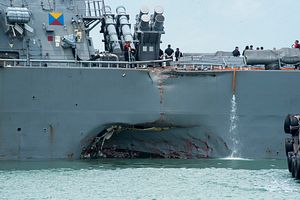The Japan-based U.S. destroyer USS John S. McCain was involved in a collision with an oil and chemical tanker around 5:24 a.m. on Monday as both ships were entering the Singapore Strait. The U.S. Navy reported that 10 sailors are currently missing, and five injured, four of which were medically evacuated by the Singaporean Navy. Already en route to a routine port visit in Singapore, the McCain proceeded under her own power and arrived at the Changi Naval base a few hours after the collision.
The collision did not occur in the Strait of Malacca, which is further west and south of Singapore, but in the eastern approach to the Singapore Strait on the South China Sea side. The Singapore Strait is still a dense and heavily trafficked area by ships en route to or exiting the Straits of Malacca, through which over 80,000 vessels transit each year.
According to images released by the Malaysian Navy, the collision appears to have occurred less than 4 nautical miles offshore as both vessels were preparing to enter the strait’s Traffic Separation Scheme, the equivalent of traffic lanes in the ocean.
The collision occurred before most of the crew would normally be awake, but since the McCain was preparing to pull into Singapore later that morning, much of the crew were probably up and getting ready for the arrival, a process that involves virtually the entire crew. Given the proximity to shore, even if the entire crew was not up yet, there would still likely have been additional crew on the bridge to supplement the navigation team and assist with the radar to keep track of other ships. In such navigational situations either the Captain or his Executive Officer, or both, would normally already be on the ship’s bridge for the same reason.
Like the ongoing investigation into the U.S.S. Fitzgerald’s collision in June that left seven sailors dead, the U.S. Navy will thoroughly investigate all factors and circumstances leading up to this mishap. There are very few answered questions as yet, but the pre-dawn watch before pulling into a port first thing in the morning is always stressful. There are long checklists and myriad preparations that have to be taken care of even before the rest of the crew takes their positions for entering port. The cacophony of reports and multi-tasking that have to be juggled can easily divide the bridge team’s attention and lead to confusion. The collision also occurred about an hour and a half before sunrise (which was at 7:03 a.m. that morning) possibly making the Alnic MC’s approach more difficult to judge visually.
At 30,000 gross tons, the Alnic MC is similar in size to the ACX Crystal that struck the USS Fitzgerald in June, about three times the size of the U.S. warship. Draft information from MarineTraffic confirms that the ship was riding high and photos of the McCain’s damage showing a hull puncture above the waterline that extends below, suggest that the tanker’s bulbous bow was partially out of the water. The photos also suggest that the Alnic MC struck the McCain at a very shallow angle, consistent with the reports that both ships were converging on the entrance to the Singapore Strait.
Unlike the Fitzgerald collision, whose damage suggests that the U.S. ship was responsible for keeping out of the ACX Crystal’s way, the McCain’s damage on the port (left) side suggests that it was the Alnic MC’s obligation to keep out of the McCain’s way under the international “rules of the road” for preventing collisions. Nevertheless, it is incumbent on both vessels to act to avoid a collision when it is imminent, and the smaller U.S. warship is considerably more nimble and maneuverable than the larger merchant vessel.
Despite being hit at a similar angle by a similar-sized ship, the McCain appears to have sustained much less damage than her sister-ship the Fitzgerald. Because she was struck aft of the superstructure, the damage was limited to the hull, and because Alnic MC was riding higher in the water, the below-water damage appears to be more limited. Compartments that far aft are also not as large as the compartments that flooded on the Fitzgerald, making the damage easier to control.
But in a heart-rending echo of the Fitzgerald’s collision, whose seven missing sailors turned out to have been trapped in their flooded berthing compartment, two of the McCain’s berthing compartments and an engineering space were also pierced and flooded. Nonetheless, it isn’t yet known whether the ten missing McCain sailors were in those flooded berthing compartments or were topside conducting preparations for entering port and possibly thrown overboard. Consequently, as of 10:00 a.m. EST, search and rescue efforts are still underway by Malaysian and Singaporean maritime authorities in the area where the collision occurred, assisted by other U.S. ships in that were in the vicinity.
In the immediate wake of the McCain’s collision, the U.S. Chief of Naval Operations, Admiral John Richardson, has ordered a review of seamanship standards and training across the entire Pacific Fleet. In addition to the Fitzgerald collision in June, there have been two other major at-sea mishaps in the Pacific Fleet over the past year; the cruiser USS Lake Champlain collided with a Korean fishing vessel in May and another cruiser, the USS Antietam, ran aground in Tokyo Bay in February, but neither incident resulted in serious injuries.
The USS John S. McCain is named for the father and grandfather of Senator John S. McCain, a Navy veteran and former Prisoner of War who chairs the Senate Armed Services Committee. Both the senior John McCains were decorated four-star admirals and veterans of the Second World War in the Pacific.
































